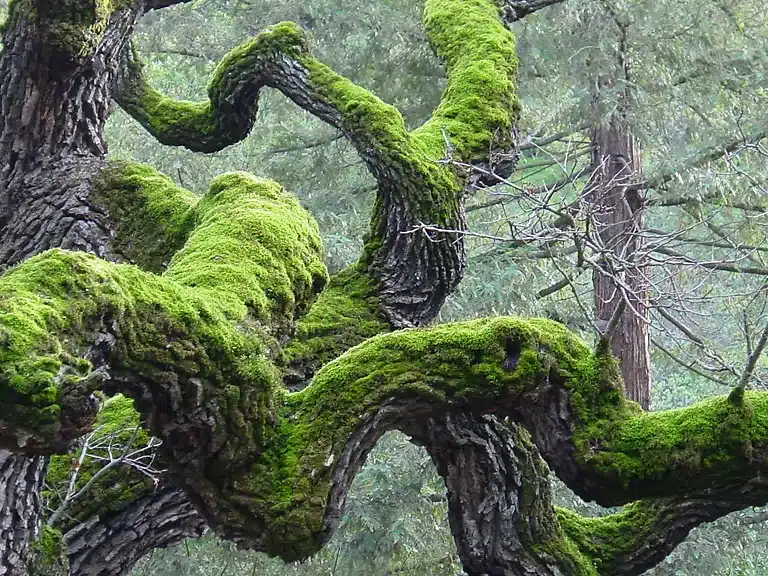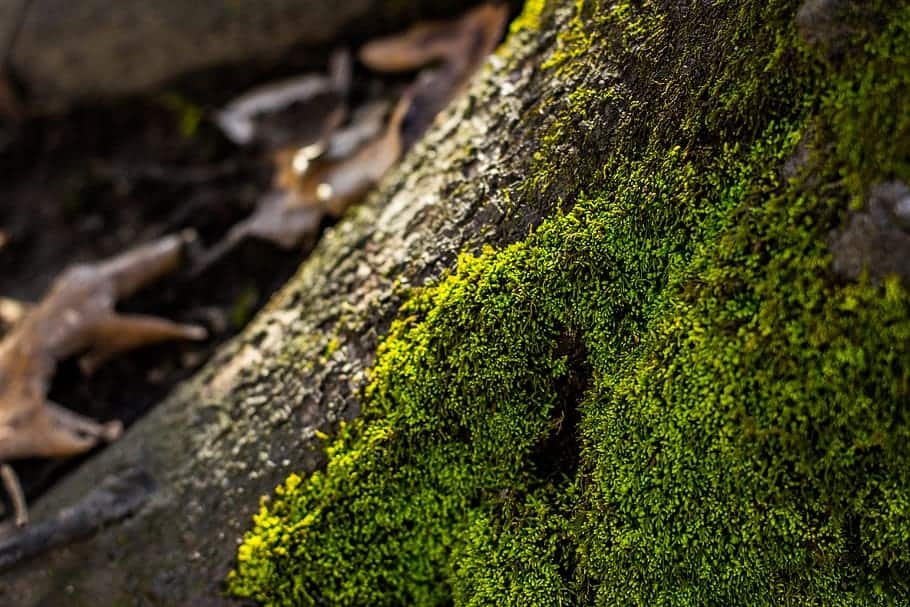Ensuring the health and longevity of your trees entails more than just admiring their beauty; it necessitates proactive upkeep to solve issues like moss growth. Moss, while appearing harmless, can reveal underlying issues that may jeopardize the health of your trees. At treeservicewestuniversity, we recognize the significance of maintaining ideal circumstances for tree growth. In this post, we’ll look at how to remove moss from trees, ensuring their health and vitality. We’ll look at practical solutions for combating moss infestations and fostering a thriving landscape, including manual procedures and environmental modifications. By making proactive efforts to address moss growth, you may ensure that your trees retain their natural beauty and durability for many years.
Understanding moss on trees
Mosses, as non-vascular plants, frequently find a favorable environment on tree trunks and branches, resulting in velvety green patches. While moss may not directly injure trees, its presence may indicate environmental imbalances. Moss thrives in wet, shady regions, indicating inadequate air circulation or high moisture retention under trees. These factors can impair a tree’s capacity to photosynthesize and may even promote the development of diseases like rot. Understanding the role of moss as an indicator species can assist tree owners in identifying potential environmental issues with their trees. Tree health can be restored by treating the root reasons for moss growth, such as shade or inadequate drainage, ensuring to remains strong and resilient in the face of environmental stresses.
The importance of removing moss on trees

Removing moss from trees is critical for various reasons. Moss can block sunlight from reaching the tree’s surface, preventing photosynthesis, which is necessary for tree growth and energy generation. Moss also maintains moisture against the tree’s bark, providing an ideal setting for fungal infections and decay to thrive. Over time, this can erode the tree’s structure and jeopardize its overall health. Furthermore, extensive moss development might signal underlying problems such as inadequate air circulation or drainage, which, if not addressed, can lead to further deterioration of the tree’s health. By removing moss regularly and addressing its underlying causes, tree owners may ensure their trees’ vitality and longevity, allowing them to thrive in their surroundings.
How to remove moss from trees?
Manual Removal of Moss from Trees
Tools required
- Soft bristle brush or scrubbing pad
- Garden hose with a gentle spray nozzle (optional)
- Ladder or platform for reaching higher areas
Steps to remove moss from trees
Assess the Area: Begin by inspecting the tree to determine the level of moss growth and any potential safety issues, such as unstable limbs or slick surfaces.
Prepare the tools: Equip yourself with a soft-bristled brush or scrubbing pad. Ensure the tools are clean and free of debris that can scrape or damage the tree’s bark.
Start from the bottom: Remove moss from the tree’s lowest portions and work up. Use gentle, circular strokes to remove the moss from the bark’s surface.
Scrub Away the Moss: Carefully scrub the tree’s moss-covered parts using a brush or scrubbing pad. Avoid applying too much pressure; this may damage the tree’s bark.
Rinse with Water (Optional): If available, use a garden hose with a gently spray nozzle to remove loose moss and debris. Begin at the top of the tree and move down, ensuring complete covering.
Inspect for Remaining Moss: After manually removing and rinsing the moss, check the tree for any remaining areas. Repeat the cleaning operation until the tree’s surface is free of mosses.
Dispose of Debris: Collect and properly dispose of any moss and debris removed from the tree. Avoid letting moss accumulate around the tree’s base since this might serve as a breeding ground for future growth.
Monitor and Repeat as Needed: Check the tree regularly for signs of fresh moss development and repeat the manual removal method as necessary. Implementing preventive measures, such as increasing air circulation and sunlight exposure, can assist in lessening the risk of moss growth.
Following these methods and using the proper tools can effectively remove moss from trees while improving their overall health and vigor.
Chemical treatments
Chemical treatments can be an effective way to control severe moss infestations or persistent development. Moss-specific herbicides are available and often contain active components like copper sulfate or fatty acid potassium salts. To ensure safe and successful use of any chemical treatment, thoroughly read and follow the manufacturer’s instructions. Begin by combining the herbicide and water in the specified dilution ratio. Using a sprayer, apply the solution to the tree’s moss-covered parts, and cover the moss completely. Avoid contact with the surrounding vegetation and take any advised safety precautions, such as wearing protective gear and gloves. After application, check for moss die-off indicators and repeat the treatment as needed. Chemical treatments should be used sparingly and only as a last resort because of their potential influence on the environment and other plant life. Consulting with a trained arborist can help you decide on the best chemical treatments and moss management strategies.
Pruning and thinning
Pruning and thinning are crucial approaches for controlling moss growth on trees. By judiciously eliminating superfluous branches and foliage, you can enhance air circulation and sunlight penetration, making moss less likely to develop. Begin by locating congested or shaded sections of the tree canopy, then carefully prune away branches to create room and allow sunlight to reach the tree’s surface. Thinning dense foliage also helps to reduce moisture retention, which reduces the circumstances that promote moss growth. Regular trimming and thinning sessions, particularly in regions prone to moss infestation, can dramatically improve your trees’ general health and vitality while inhibiting moss colonization.
Adjusting environmental factors
Adjusting environmental variables near trees can successfully inhibit moss growth. Moss flourishes in wet, shaded environments, therefore changing the tree’s surroundings can restrict its growth. Trim adjacent vegetation or decrease the tree canopy to increase sunlight exposure at the tree’s surface. Improving soil drainage around the tree’s base helps to keep water from collecting and reduces excess moisture, which promotes moss growth. Furthermore, eliminating waste and organic materials from the ground under the tree might reduce the nutrients available to moss, limiting its growth. By making these environmental changes, you create an unfavourable environment for moss, promoting the health and vitality of your tree.
Related Posts:
- What To Do With Uprooted Trees
- How to Remove Palm Tree Stump
- tree trimming service
- Stump grinding service
FAQS
1. Are mosses damaging to trees?
While moss does not immediately injure trees, its presence can indicate underlying problems such as inadequate air circulation or excessive moisture retention, jeopardizing tree health over time.
2. Can I just scrape off the moss off my trees?
Manual removal of moss with a soft-bristled brush or scrubbing pad is effective. However, to prevent moss growth from occurring again, the underlying causes must be addressed.
3. Are chemical treatments safe for both my trees and the environment?
Chemical treatments should be used sparingly and according to product directions. Consult a professional arborist to ensure chemical treatments are used safely and appropriately.
4. How frequently should I remove moss from my trees?
Various factors, including local climate, tree species, and environmental circumstances, determine moss removal frequency. Regular monitoring and maintenance can assist in deciding the best time to remove moss.
5. What precautions can I take to avoid moss growth on trees?
Improving air circulation, increasing sunlight exposure, and improving soil drainage around trees can all contribute to a less favourable environment for moss growth. Regular trimming and thinning can also prevent moss invasion.
Conclusion
How to remove Moss from trees is critical to their health and vitality. By combining hand removal techniques, environmental changes, and preventive measures, you can efficiently manage moss development and maintain your trees’ health. Regular monitoring and maintenance are essential for detecting and eliminating moss infestations quickly, ensuring that your trees thrive in their habitat for years. Consider talking with a licensed arborist to create a customised moss control plan for your trees.

